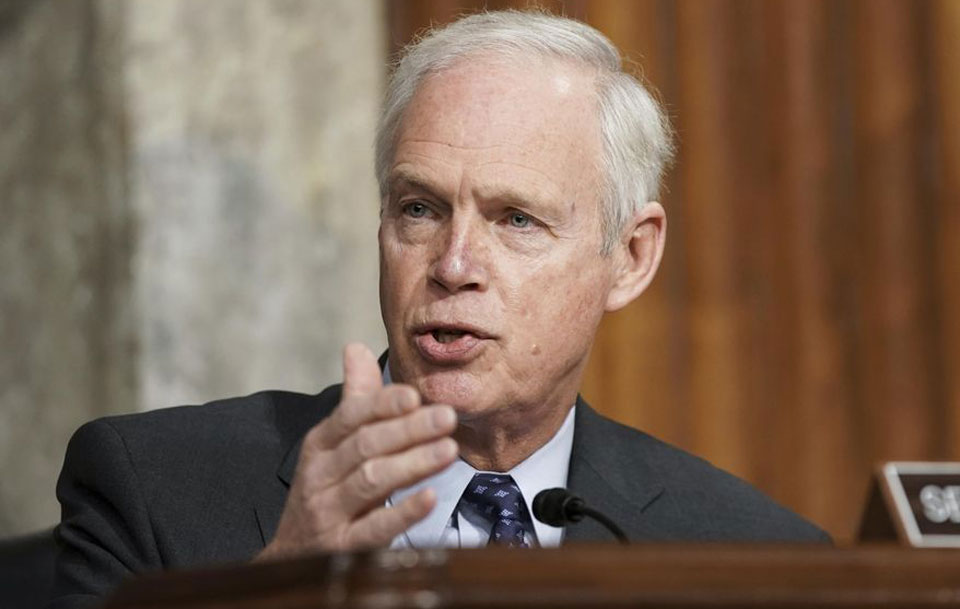
WASHINGTON—The 2,700-page $1 trillion five-year infrastructure bill the evenly divided Senate slogged through during the first week of August has a lot that’s in it for airports, ports, subways, buses, broadband, highways, and bridges.
It has two big items, tax hikes, that are out, along with the long-proposed National Infrastructure Bank for key projects.
And it almost fell victim to a “poison pill” GOP amendment on the Senate floor.
“As has been proven time and time again, broad and robust infrastructure investment is the core foundation for sustained economic growth,” said North America’s Building Trades President Sean McGarvey after the Democratic-run House passed the highways-mass transit section of the infrastructure plan. That Invest In America Act (HR3684) is the basis for the entire legislation.
“The over $700 billion in funding provided for roads, bridges, transit, rail, clean water, and drinking water systems is the type of scale we desperately need to upgrade our nation’s outdated and crumbling infrastructure,” he added.
“The Invest In America Act ensures strong prevailing wage coverage for building trades members, and will provide training opportunities for those seeking a career in construction– especially women, communities of color, military veterans, and the formerly incarcerated.”
The bill “would provide every American with access to reliable high-speed internet and make the largest federal investment in public transit, bridges, and clean drinking water,” said Teachers President Randi Weingarten, who praised Biden for carrying out his promise to invest in well-paying union jobs.
But even as senators were totting up and arguing about the measure, Sen. Ron Johnson, R-Wis., almost drove it, a key part of Democratic President Joe Biden’s program, off the road and into a ditch with his Mexican Wall “poison pill.”
Wrapping himself in Donald Trump’s anti-Hispanic jihad, Johnson tried to mandate construction continue on the ex-Oval Office occupant’s racist Mexican Wall. It’s infrastructure, and Johnson said so. But he blamed Biden—not Trump—for “a complete denial” of border problems. His amendment to fund contracts for the wall, even for unbuilt sections, lost 48-49 on Aug. 4.
Three GOP senators were absent, including one—South Carolina’s Lindsay Graham—down with the coronavirus. Sen. Joe Manchin, D-W. Va., voted with the remaining 47 Republicans to keep the wall. The other 47 Dems and both independents voted to defund the wall.
That defeat preserved the deal, which a bipartisan group of ten senators, five from each party, worked out. Both parties admitted they didn’t get everything they wanted, but both also got enough to provide a bipartisan 67-32 vote, including 17 Republicans—seven more than necessary—to get debate started on Aug. 1.
“The deal will create good-paying union jobs,” a Biden White House fact sheet declares. “With the president’s Build Back Better agenda, these investments will add, on average, around two million jobs per year over the course of the decade, while accelerating America’s path to full employment and increasing labor force participation.”
Senators rejected most amendments so far, including Johnson’s, but must plow through 200 or so. Uncontroversial ones passed. That left key provisions of the measure intact. Top ones include, but are not limited to:
- $110 billion over five years for reconstructing roads, bridges, and major projects, the fact sheet says. The Green New Deal isn’t in the bill—that would get both Republicans and some construction union leaders mad—but “green” highway projects are.
“This investment will repair and rebuild our roads and bridges with a focus on climate change mitigation, resilience, equity, and safety for all users, including cyclists and pedestrians,” the fact sheet says. The “major projects” are multimodal transportation projects. They’d get $6 billion over five years.
Bridge repairs, rehab, and replacement alone would get $40 billion of the overall sum. Experts note 45,000 bridges are in poor condition. And there would be new grant programs for carbon emissions cuts, $7.5 billion for electric vehicle charging stations—at a maximum of $15 million each—and for electrification at ports to reduce truck emissions.
That’s a big issue in Los Angeles-Long Beach, where the Teamsters have used the emissions issue in their campaign to organize port drivers.
The federal government would pick up 80% of the tab for grants throughout the measure. How they’ll be paid for is another matter.
- $39 billion in new capital investments for mass transit, including subway cars, bus fleets, new stations, and making them accessible to the disabled. That’s in addition to five more years of operating subsidies, especially for medium-sized and smaller cities.
The new capital money “will replace thousands of transit vehicles, including buses, with clean, zero-emission vehicles. And it will benefit communities of color since these households are twice as likely to take public transportation and many of these communities lack sufficient public transit options,” the fact sheet says.
- $50 billion for water infrastructure. That includes half a billion dollars—at least—over the five years to replace all of the nation’s lead-lined water pipes and another $200 million to get lead out of drinking water in U.S. schools. There are also specific sums to target low-income and communities of color for the lead removal projects.
Pediatrician and professor Mona Hanna-Attisha exposed the lead-in-water crisis more than five years ago for all to see. She blew the whistle on the Flint, Mich., water catastrophe. The GOP white-run Michigan government imposed an administrator on the majority-Black city. Snyder’s appointee attempted to save money by switching Flint’s water source to one that leached the lead from Flint’s ancient pipes. That contaminated the water, and kids’ brains.
- $17 billion for port infrastructure and $25 billion in airports “to address repair and maintenance backlogs, reduce congestion and emissions…and drive electrification and other low-carbon technologies.” The fact sheet says “removing bottlenecks” at ports and airports “will support U.S. competitiveness” and jobs.
- $7.5 billion, split into equal thirds, for ferries, zero-emission school busses, and low-emission busses.
- $66 billion to upgrade, improve and—most importantly—speed up Amtrak. That includes $5 billion for high-speed rail, with other money split between the Northeast corridor and increasing service, and speed, in the rest of the nation.
Highways and mass transit have dedicated funding through the federal gas tax—even though it falls far short of what’s required and has for years. Amtrak and freight railroads don’t.
“The deal positions Amtrak and rail to play a central role in our transportation and economic future,” the administration’s fact sheet contends. Though it didn’t say so, Biden personally pushed the Amtrak money. He commuted from his home in Wilmington, Del., to D.C., via Amtrak every working day of his 36-year Senate career, making friends with the unionized rail workers. Biden isn’t called “Amtrak Joe” for nothing.
“Let’s not be fooled by the headline number. What’s really in this bill is $32 billion in additional passenger-rail funding over and above the baseline–which is a great start, but a long way from the transformative vision” Biden offered, retorted Rail Passengers President Jim Mathews, in an article cited on the Railway Workers United website.
- $65 billion to upgrade broadband, extend it nationwide, and make sure low-income people can afford it. The pandemic showed how vital connectivity is now, and 30 million people are without it. Extending broadband is a top Communications Workers goal, since broadband, wireless phones, and Wi-Fi are replacing traditional hard-wired phones.
“If the pandemic taught us anything, it taught us that everybody needs broadband. It’s like electricity or water,” union President Chris Shelton said in July. “CWA has been pushing for universal high speed internet access for 15 years. We support a shared partnership between private companies and the federal government to get this done.
“But Congress needs to make sure it’s done right, with experienced, trained union workers, not low-wage subcontractors who make a quick buck and skip town.”
“The bill will also help lower prices for internet service by requiring funding recipients to offer a low-cost affordable plan, by creating price transparency and helping families comparison shop, and by boosting competition in areas where existing providers aren’t providing adequate service,” the fact sheet says.
Now for what’s not in the legislation:
- The Green New Deal, by name. Much of it is in a parallel $3.5 trillion “reconciliation” bill—whose chances are a lot dicier and which hasn’t been unveiled yet. But there are several “green” sections in the infrastructure bill.
Reconciliation’s success is tied to the infrastructure bill’s ultimate fate. Democratic progressives, the largest caucus in the House, are warning Biden that unless the bigger measure passes, too, they’ll walk. Reconciliation includes more of the Green New Deal, education and home health care money, permanent paid family and medical leave, and bigger fines against labor law-breakers, among other progressive measures.
- General tax hikes, of any kind. This big bugaboo almost landed the entire bill on the rocks. Biden absolutely refused to raise taxes on middle- and lower-income families. That ruled out the first federal gasoline tax increase since the Reagan administration.
Never mind that gas tax revenues are supposed to fund highway and mass transit projects. Those revenues have fallen short for years. But gas taxes also hit low-income people harder.
The Republicans’ red line in the sand was any increase in taxes on corporations and the rich, cutting into the bonanza Trump and GOP lawmakers gave them in 2017.
As a result, the bill finds more than half of its spending by shifting $205 billion already set aside to battle the coronavirus, but as yet unspent, OpenSecrets.org reported. No sponsors said a word about if that cash would be needed to battle the virus’s galloping Delta variant.
The rest would come from a grab-bag: $53 billion in remaining unemployment benefits, $49 billion by delaying a Trump Medicare rebate, and $56 billion from “projected economic growth over five years” from benefits of the infrastructure work.
To ensure the Trump tax cuts stayed intact, the Chamber of Commerce spent $29.5 billion overall for infrastructure lobbying in the first half of the year, OpenSecrets reported. By contrast, the AFL-CIO spent $2.2 million, trailing the Chamber, the Business Roundtable, and the National Association of Manufacturers. All three lobbied for building the infrastructure and lobbying against having business—which would profit—pay for it.
- More money for education. That would be in the separate, larger “reconciliation” bill lawmakers are still crafting, AFT President Weingarten said.
- Effective equity measures in the building trades, according to union-created Chicago Women In Trades, the National Taskforce on Tradeswomen’s Issues, and allied organizations. They worked for an amendment by Sen. Kirsten Gillibrand, D-N.Y., to mandate that. It hasn’t come up yet.
Gillibrand would mandate states use 0.5% of federal construction money for their projects—about $50 million per state–“to increase the overall demand for women and people of color in infrastructure construction job opportunities, remove barriers to entering and remaining in these well-paid jobs and expand the capacity of states to provide supportive services necessary for those workers to succeed,” the groups said.
At least one construction union already provides such support services. The Bricklayers, the Ironworkers, and the Carpenters also support Gillibrand’s amendment, says Jayne Vellinga, executive director of Chicago Women In Trades.
“Women, and especially women of color, have been overlooked when it comes to infrastructure jobs in construction and manufacturing.” Leah Rambo, Training Director of SMART Local 28 and the national task force co-director said in their statement. “These high-wage jobs give women the ability to take care of ourselves and our families, and we have proven time and again that we have the grit needed to excel in these jobs.”

MOST POPULAR TODAY


Zionist organizations leading campaign to stop ceasefire resolutions in D.C. area

High Court essentially bans demonstrations, freedom of assembly in Deep South

Afghanistan’s socialist years: The promising future killed off by U.S. imperialism

Communist Karol Cariola elected president of Chile’s legislature






Comments